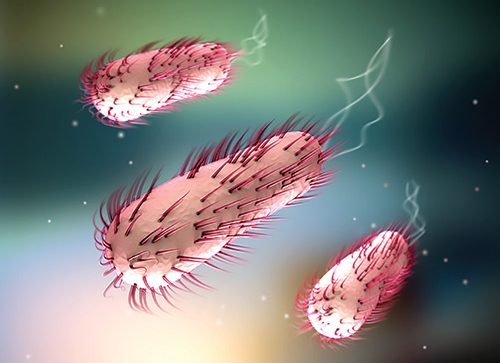Most types of Escherichia coli are harmless, but the ones that aren’t can cause severe life-threatening diarrhea. These problematic bacteria launch infections by inducing intestinal cells to form tiny structures (pedestals) that anchor the pathogens in place and help the colonies grow.
Now, researchers report in mBio (“Pathogenic Escherichia coli Hijacks GTPase-Activated p21-Activated Kinase for Actin Pedestal Formation”) that they have discovered an Achilles heel for disabling pedestal formation. Lab experiments on enteropathogenic and enterohemorrhagic E. coli (EPEC and EHEC) showed that when the pathogens were prevented from injecting a protein called EspG into intestinal hosts, the hosts were slower and less effective in producing pedestals that fixed the bacteria in place. Further investigations revealed the cellular pathways hijacked by EspG.
“Enteropathogenic Escherichia coli and enterohemorrhagic E. coli are extracellular pathogens that reorganize the host cell cytoskeleton to form ‘actin pedestals’ beneath the tightly adherent bacteria, a critical step in pathogenesis. EPEC and EHEC inject effector proteins that manipulate host cell signaling cascades to trigger pedestal assembly. One such effector, EspG, has been reported to bind and activate p21-activated kinase (PAK), a key cytoskeletal regulator, but the function of this interaction and whether it impacts pedestal assembly are unknown,” the investigators wrote.
“Here, we demonstrate that deletion of espG significantly impairs pedestal formation and attachment by both EPEC and EHEC. This role of EspG is shown to be dependent on its interaction with PAK. Unexpectedly, EspG was able to subvert PAK only in the presence of Rho family small GTPases, which function to both concentrate PAK at the membrane and stimulate PAK activation. Our findings reveal a novel mechanism by which EspG hijacks PAK and sustains its active state to drive bacterial attachment to host cells.”
The findings can help reveal the mechanics of infection and suggest new avenues of treatment, said microbiologist and study co-leader Peter Hume, PhD, at the University of Cambridge in the U.K. “By learning how these pathways work, we think we can develop new ways of interfering with the infection process,” he said.
Worldwide, more than 500,000 children die every year from diarrheal diseases, and pathogenic strains of E. coli are among the most common causes, according to the World Health Organization. But treating these infections can be tricky. Using antibiotics to treat a person with EHEC, for example, can trigger the bacteria to release Shiga toxin, which can lead to a life-threatening infection similar to sepsis. That means health care providers need treatments other than antimicrobials to keep these infections in check, Hume said.
Scientists have long known that pathogenic E. coli injects its host with a variety of proteins, including EspG. Until now, however, those interactions have been linked only to other biochemical functions. “People had tried to find a link to pedestals before, but they hadn’t found one,” said Hume, whose work focuses on how bacterial pathogens affect the cytoskeletons of host cells.
Previously, researchers studied the effects of EspG on macrophages, and those findings suggested the protein may have an overlooked role in pedestal formation with intestinal hosts.
For the current study, they infected one group of Hap1 cells with wild-type EHEC and EPEC, and infected another with the same types of E. coli, but lacking the genes responsible for producing EspG. Using fluorescence microscopy, the researchers studied the results. The cells infected by E. coli lacking EspG took longer to produce pedestals the those by wild-type strains, and what pedestals were produced were shorter.
Follow up experiments revealed that the EspG protein hijacks the host cell by scavenging an active enzyme called PAK. Although previous work has shown a link between EspG and PAK, the new study is the first to connect the two to the formation of pedestals.
That connection may help researchers studying other diseases, as well. PAK has been implicated in some cancers, and other studies have shown that some viruses, including HIV, can activate it.
“This study may well have implications with other pathogens that manipulate the same pathways,” according to Hume.


